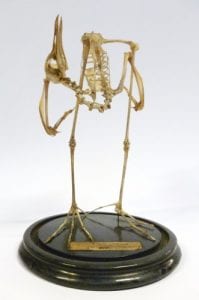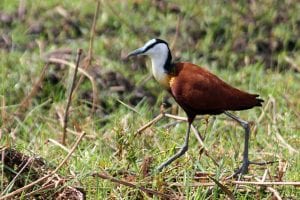Specimen of the Week 332: African Jacana
By Dean W Veall, on 2 March 2018
Dear Specimen of the Week readers, Dean Veall here in what is my LAST EVER Specimen of the Week post. If I were to choose my favourite it would definitely be SOTW 199: Jar of… But, enough of the nostalgia. I am picking up the baton from Jack and Hannah and have chosen a specimen from our collection that explore stories of women in natural history, amazing female natural history and the language of gender in zoology to help mark International Women’s Day on Thursday 8 March. This week I’ve chosen…
**African jacana (Actophilornis africanus) skeleton**
Museum Manager Jack Ashby highlighted in his book and in a recent article for Conversation the bias of natural history museums not only in how male and female specimens are displayed but also in the language used to describe the nature of the different sexes of species with females venerated as mothers and have caring natures, all ‘womenly’ traits. So I’ve chosen a specimen that exhibits a form of behaviour that is rarely mentioned in museums or natural history documentaries.
Mating on display
Polygamy (multi-mate reproductive behaviour) is the dominant mating system across the animal kingdom. In displays museums tend to place emphasis on either the promiscuous behaviour of males with their displays of birds such as the bird of paradise highlighting their colourful plumage or on dominant males with their hareem of subordinate females (polygyny (one-male, multi-female groups)) with their choice of silver back gorilla taxidermy or skulls of giant deer. These are more than often used to explain the evolutionary results of this mating behaviour. Females do get a look in with female choice being used in interpretation to explain the selective pressures that resulted in these often time ridiculous (and beautiful) males ornaments. However, to my mind, I’ve not seen an example of the female multi-male version of polygamy, polyandry, on display in museums.
Polyandry
Literally meaning “many males”, polyandry is a class of mating system where one female mates with multiple males. Whilst common in insects it is thought to be rare in vertebrate groups, although common in guppies, only about 1% of birds and some species of our primate relatives marmosets exhibit this form of behaviour. The classical form of polyandry usually involves a reversal of sexual roles with females receiving a direct and distinct benefit from this form of mating.
African jacana
Proudly nestled amongst our bird display is the African jacana (Actophilornis africanus), the sex of this specimen is unknown but lets say she’s a female. Like other females in this group of birds that are found in the freshwater wetlands of sub-Saharan Africa she is distinct from the male by her size, she is larger. Her larger size allows her to defend her territory from females who would be potential rivals. Within her territory she will tolerate several males, males with which she will mate with all year round. After a fairly simple courtship she will lay a clutch of eggs in the nest the male has carefully made and leave the male to have sole responsibility for the incubation of the eggs and raising of the young.
What’s wrong with that?
The notion of sex role reversal and ‘abandonment’ of young is provocative and historically used to judge and condemn women as failures and even today this language associated with the behaviour of the African jacana will feature in the more salacious stories written about women and used to promote a culture of shaming women. So, are these social ‘norms’ and ideas around motherhood one of the reasons why this behaviour is poorly represented in natural history on the screen and in displays? Possibly. But this is a rare behaviour and there is lots still we are uncovering in behavioural ecology which might explain it’s absence.
Dean Veall was Learning and Access Officer at the Grant Museum of Zoology.
 Close
Close




